Florida Produce Shines In Spring
February 1, 2016 | 10 min to read
The article highlights how the Sunshine State plays a vital role in providing fresh spring vegetables to the northern U.S. Florida dominates the production of crops like tomatoes, cucumbers, and sweet corn, significantly contributing to the national market. With a focus on quality and freshness, retailers are encouraged to promote Florida-grown produce, leveraging consumer interests in sustainable sourcing. The emphasis on local, healthy choices aligns with growing trends, ensuring Florida remains a key player in supplying fresh produce year-round.
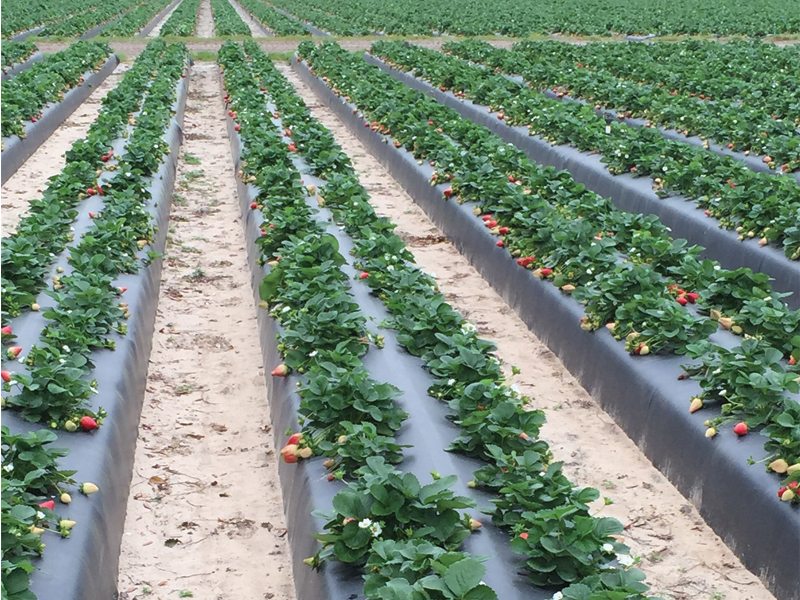
The ‘Sunshine State’ delivers the first signs of Spring to the northern U.S.
The Top 10 fresh spring vegetable crops in Florida, according to statistics supplied by the Florida Fruits and Vegetable Association, are tomatoes, peppers, sweet corn, snap beans, cucumbers, cabbage, squash, celery, eggplant and lettuce. That’s an impressive and varied list that keeps consumers in northern states well stocked with fresh commodities and salad ingredients several months before winter releases its frigid grip.
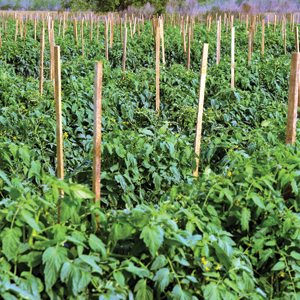
Photo Courtesy of Weis-Buy
In 2014, Florida delivered nearly 40 percent of the total U.S. value for fresh market cucumbers and tomatoes, with a combined value of over a half billion dollars. Snap beans were close behind at 35 percent with bell peppers and squash at 27 and 21 percent respectively. Sweet corn neared 20 percent of the fresh market value with $130 million.
In addition to ranking first in U.S. production value for citrus fruit, as one may expect, the Sunshine State is also first in cucumbers (more of which end up pickled than any other state producer), snap peas, squash and tomatoes. Sugarcane and watermelons also top the list.
According to USDA National Agricultural Statistics Service (NASS), tomatoes led the way in 2014 as well with a peak season falling in April and May. That same year, Florida led the country, producing 924 million pounds on 33,000-harvested acres for a production value of $437 million. Strawberries are the second leading crop in both the state and the country with more than 207 million pounds produced on nearly 11,000 acres for a production value of $307 million.
Other commodities that hit their peak in early to late spring are bell peppers, spring potatoes, sweet corn, snap beans, cucumbers and squash, and all are nationwide leaders ranked either first or second with cabbage coming in at third.
“It’s really important for consumers these days to know where their food comes from and to know it is high quality, healthful and fresh. Retailers who source spring vegetables from Florida are certainly offering that to today’s consumers.”
— Lisa Lochridge, Florida Fruit and Vegetable Association
There is little doubt consumers don’t want fresh produce, especially in the winter months, and retail produce executives can take advantage of the myriad tools at their disposal to promote it. Signage, packaging and labels, even social media platforms are all effective ways in which produce departments can promote the state of Florida and its message of health, great taste and sustainability.
Restaurant buyers can draw attention to Florida growers and the commodities they harvest wherever they appear on the menu. While utilizing these tools are highly beneficial in promoting Florida produce and increasing profits, the commodities themselves provide excellent marketing as well. Well-stocked, attractive displays where consumers can touch and feel the freshness, will keep them in a Florida-state-of-mind as the ice and snow begins to thaw.
Florida, The Nation’s Backyard
“Consumers want to know where their food comes from,” observes Brian Rayfield, vice president of business development for J&J Family of Farms based in Loxahatchee, FL. “I think if we can tell the story about our farms and how we do things, it will resonate with consumers in northern states.”
J&J Family of Farms is a grower and shipper based in Palm Beach County. The company recently partnered with Boca Raton, FL-based Thomas Produce to manage a total of 15,000 acres to grow green bell peppers, green and yellow squash, eggplant and green beans.
Rayfield says while folks in colder climates may aspire to eat as much locally sourced produce as they can, the weather in much of the country makes this request impossible for several months of the year.
When vegetables can’t be sourced from local growers, consumers can trust the arrival of fresh produce from Florida throughout the winter and into the spring. Even in the summer and fall, Florida produce continues to complement offerings in the produce department.
Rayfield says when consumers outside of Florida realize they can’t have locally grown produce 12 months a year, “they can associate with the grower in Florida. They might say to themselves, if this grower was here in my state, I would like to eat this product. I do think that ‘Buy USA’ is something the state of Florida should attempt to leverage.”
That sentiment is echoed by other growers who feel consumers who value local, should support produce grown in the U.S. whenever possible.
Dan Jost, general manager of the southeast region for Robinson Fresh headquartered in Eden Prairie, MN, also sees Florida’s ability to deliver fresh produce fast as a great advantage for retailers. “The primary advantage to Florida-vegetable production continues to be its strategic value to Central and Eastern-based receivers versus West Coast production. Retailers reduce fuel miles and transit times, receive fresher product, and gain satisfaction in knowing they’re not only diversifying their supply, but supporting regional and local growers.”
Retailers can educate their customers by emphasizing the fact that Florida produce offers the freshest U.S.-grown option to consumers when obtaining locally sourced commodities isn’t an option.
“It’s really important for consumers these days to know where their food comes from and to know it is high quality, healthful and fresh,” says Lisa Lochridge, director of public affairs for the Florida Fruit and Vegetable Association based in Maitland, FL. “Retailers who source spring vegetables from Florida are certainly offering that to today’s consumers. Local means different things to different people, and what we found is consumers really do regard Florida produce as local when it’s not available near them.”
Lochridge recommends retailers work with growers to promote Florida produce utilizing point-of-sale materials, displays and signage to make the product pop and grab the attention of busy shoppers. “With trends that are popular with consumers today, they want to know more about where their food is grown, where it comes from, and to be assured they’re making healthy choices. Florida produce fits all that criteria, and gives us something strong to stand on during the spring,” says Lochridge.
Quality Trumps Local
While an increasing number of consumers may be interested in locally sourced produce, not everyone is. Many consumers are confident in their own ability to judge quality produce.
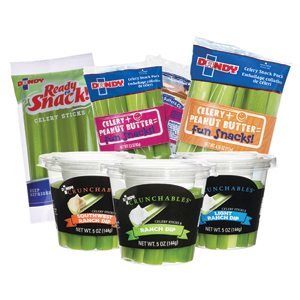
Photo Courtesy of Duda Farms
“We don’t have a very local-sensitive clientele,” says Dan Dvor, manager of A&N House of Produce in Philadelphia. “They’re much more sensitive to quality and appearance, and obviously price. Whenever we buy Florida produce we’re buying from that particular grower and area, because we know it’s the best quality. It’s the quality that helps us promote product.”
Lee Anne Oxford, director of marketing at L&M Companies in Raleigh, NC, sees value for retail produce managers in promoting the positive attributes of their commodities.
L&M is a grower and packer that manages 5,000 acres in Florida and produces a variety of spring vegetables such as green bell pepper, squash, zucchini, cucumbers, chili peppers, eggplant, cabbage, broccoli, greens and potatoes. Oxford says the biggest advantages in the produce departments of eastern retailers are “freshness, shelf life and freight savings,” as well as Fresh From Florida brand recognition.
When asked the best ways for retailers to promote Florida vegetables, Oxford was ready with a long list of effective tools: “advertising, shelf talkers, store banners, Fresh from Florida bins and packaging. We have overwrap trays, labels and Florida poly bags and bins. We also do local POS signage and ad programs.” For Dvor at A&N, Instagram and Facebook are good ways to mention growing location as part of overall product description. He says the Florida name alone is often enough to connect these commodities with quality.
“Whenever we buy Florida produce we’re buying from that particular grower and area, because we know it’s the best quality. It’s the quality that helps us promote product.”
— Dan Dvor, A&N House of Produce
Supporting U.S. Farmers
Buying healthy, organic vegetables is great, but perhaps the more compelling reason to buy Florida produce is to support Florida growers in what is a very competitive North American market.
For Tom Wilson, sales manager at Alderman Farms based in Boynton Beach, FL, buying Florida produce goes beyond health trends and sustainability movements. Buying from Florida growers supports growers, farms and the many workers involved in picking, packing and transport.
“The main benefits are that it’s a U.S. product,” says Wilson. “It’s helping local farmers. It helps with their sustainability programs, and it keeps farming alive in the U.S. For smaller growers — and all growers really — it is a struggle to compete with cheaper prices coming from south of the U.S. border.”
Promoting sustainability should certainly include Florida growers in the U.S. To help satisfy consumer demand for healthier products, Alderman Farms provides organic alternatives, and while that helps reach consumers concerned with pesticide use, there is increased competition from Mexico in organics as well. “The main idea of a sustainability program, you are offering organic options to your customers,” says Wilson. More people are tuned into the benefits of organic, so prices are actually coming down over the years as everyone has more experience with the crop. While sustainability and organics are appealing to many consumers, “price is what pushes it,” concludes Wilson.
Promotional Volumes
Spring’s biggest holiday, Easter, is a good opportunity for retailers to promote Florida produce. “For big holiday eating occasions, there will be promotable volumes of sweet corn,” says Nichole Towell, director of marketing at Duda Farm Fresh Foods headquartered in Oviedo, FL. “We planned an increase to cover customers’ needs. We will also have promotable volumes of celery and radishes — both are cooking and snacking staples.”
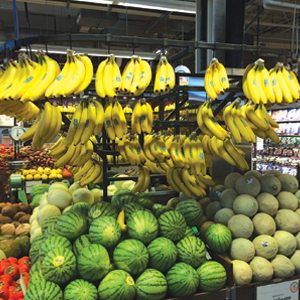 There are opportunities for retailers to begin promoting commodities — even as winter still reigns, according to Towell. “Run times for Florida-grown produce can vary depending on the weather. For example, celery season is January through April, with promotional time mid-January through mid-April. We also use the Fresh from Florida logo on all items to generate awareness for our products and where they’re grown.”
There are opportunities for retailers to begin promoting commodities — even as winter still reigns, according to Towell. “Run times for Florida-grown produce can vary depending on the weather. For example, celery season is January through April, with promotional time mid-January through mid-April. We also use the Fresh from Florida logo on all items to generate awareness for our products and where they’re grown.”
Florida’s sweet corn season begins in mid-November and lasts through May, so promotional volumes are available in early spring and consumers expect to see fresh ears in the produce aisles at that time. The season for lettuce and leaf items in Florida starts mid-December and continues through April, so the promotional time for these commodities start in mid-January and lasts through March. Retailers have many opportunities to promote fresh produce sales during the early days of the spring season.
The Personal Touch
The advantages of procuring and promoting the freshness and availability of Florida produce are apparent to the senses. Simply touching and smelling crisp snap beans or a firm, ripe tomato is a major selling point. Produce displays that are well-stocked, colorful and attractive convey a message of health and bounty.
There are other tools retailers can use to boost sales in the spring. “Retailers can use shelf strips and talkers to feature the growing geography, and educate the consumer about the freshness of the regional grown product,” says Jost at Robinson Fresh.
Consumers who are concerned about the source of their produce like to make a personal connection to the grower. To achieve this, Jost says personalized signage yield good results. “Many retail locations often have a picture of the grower to help the consumer connect with the farm and its crop.”
Jost suggests restaurants take advantage of this selling point as well. “Restaurants can train their employees to speak to the regional product as they walk customers through the menu or specials. Today’s consumers enjoy learning about the supply chains behind their food selections.”
Scott Seddon, brand manager at Pero Family Farms headquartered in Delray Beach, FL, echoes this sentiment. “If it is not locally grown for your region, it is domestically grown,” he says. “Florida has healthy soil and farms that produce nutritious vegetables. It’s no secret that Florida is full of sunshine in the winter, and that is one of the main ingredients for great produce.”
Full-Flavored Florida Tomatoes
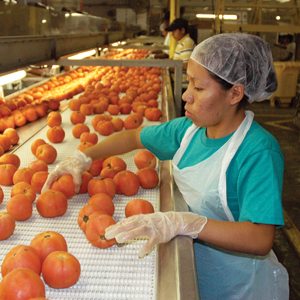
Photo Courtesy of Weis-Buy Farms
The growing season for Florida tomatoes is October through June with the peak period falling in April/May. In 2014, according to a report by the USDA’s
National Agricultural Statistics Service, Florida ranked No. 1 in U.S. production of tomatoes, leading the country with 924 million pounds grown for a total of $437 million in production value. Florida has a hard-fought reputation for producing quality tomatoes, and that’s a result of a lot of hard work by growers.
Due to the high regard the public has for its products, the Maitland,FL-based Florida Tomato Committee believes retailers would be wise to emphasis the benefits of fresh tomatoes from Florida. In addition to large bountiful displays in the produce department, secondary displays with packaged salad, as well as in the meat department, are effective ways to promote them. Placing them next to items in the produce department, such as onions, carrots, cucumbers or lettuce can get that healthy, flavorful salad in the minds of shoppers even if those items aren’t on their shopping lists.
According to Reggie Brown, manager of the Florida Tomato Committee, “the Florida tomato during the winter, from fall to early spring, is truly the home-grown American tomato. Most of the rest of the product, certainly in the large-round category, is coming from outside the country — primarily Mexico.” Buying Florida tomatoes, he says, “gives retailers the opportunity to feature a tomato grown for Americans by Americans.”
 The Florida Tomato Committee is the regulating authority for the tomato production areas of Pinellas, Hillsborough, Polk, Osceola, Brevard as well as other counties. The Committee created high standards on the tomatoes that get shipped to restaurants and retail outlets north of the Florida/Georgia state line, and Florida growers work hard to meet them. “We, in Florida, spent a lot of time and a lot of money building this product,” says Chuck Weisinger, chief executive of Weis-Buy Farms based in Fort Myers, FL. “You see today, compared with the tomatoes we sold 20 or even five years ago, it’s a healthier product, it’s a better product, and it’s a cleaner product, and nothing goes out unless it’s healthy — so there’s very little chance of disease or problems with the tomatoes.”
The Florida Tomato Committee is the regulating authority for the tomato production areas of Pinellas, Hillsborough, Polk, Osceola, Brevard as well as other counties. The Committee created high standards on the tomatoes that get shipped to restaurants and retail outlets north of the Florida/Georgia state line, and Florida growers work hard to meet them. “We, in Florida, spent a lot of time and a lot of money building this product,” says Chuck Weisinger, chief executive of Weis-Buy Farms based in Fort Myers, FL. “You see today, compared with the tomatoes we sold 20 or even five years ago, it’s a healthier product, it’s a better product, and it’s a cleaner product, and nothing goes out unless it’s healthy — so there’s very little chance of disease or problems with the tomatoes.”
The health benefits associated with this versatile fruit are expansive. Myriad studies from institutions such as the American Cancer Society, Harvard School of Public Health’s Department of Nutrition, and University of Illinois prove tomatoes can help the lungs repair from damage caused by smoking, and their high-lycopene levels have been shown to reduce the risk of prostate, stomach and colorectal cancers. And additional lycopene is produced by tomatoes through cooking.
While most consumers are quite familiar with tomatoes, their reputation has taken a hit in the past with critics who decried their lack of flavor. According to Weisinger, the issue has been resolved. “The tomato crop in Florida supplies about 60 percent of Americans, and part of the Canadian market with fresh tomatoes. The American farmer perfected tomatoes to where we changed the flavor. The cost of Florida tomatoes today is approximately $11,000 an acre, so we’re spending an awful lot of money in Florida to give the consumer the best product we can. The price itself can be cut to the Northeast because of the shortness of time. It’s safe, it’s healthful, it tastes good, and it’s not the cardboard that the press complained about 15 years ago. It’s a whole different product.”
2 of 17 article in Produce Business February 2016

